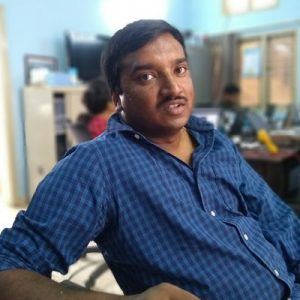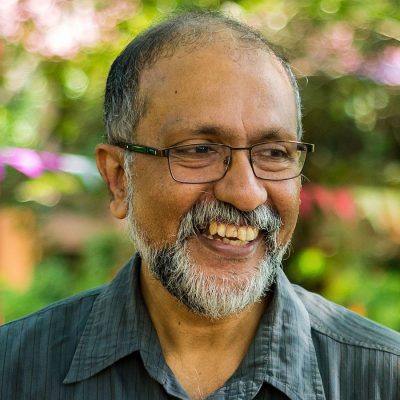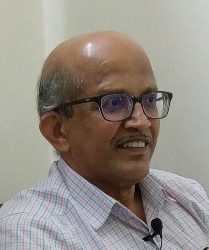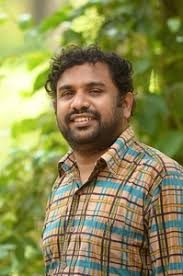Episode 4: Ashwin Whitchurch
 Curious about how and why somoene would build hardware and share the designs and source code of that hardware? Want to get started with designing your own hardware? Wondering about how hardware developers and companies that build and share their hardware designs remain viable?
Curious about how and why somoene would build hardware and share the designs and source code of that hardware? Want to get started with designing your own hardware? Wondering about how hardware developers and companies that build and share their hardware designs remain viable?
In this episode, Ashwin shares details of how he got started with embedded device development and how he built and released multiple devices as Free/Open Source Hardware.
Ashwin Whitchurch specialises in embedded system design and development with a specific focus on embedded medical devices. He is the founder of ProtoCentral where they build and provide embedded products, devices and components to developers and users. Ashwin is also the developer of the HealthyPi and HeartyPatch boards which are available for order on Crowd Supply.
Transcript
[00:00:00]
[Abhas] Welcome, Ashwin. So we are trying to do a series of audio recordings with some of the delegates here at the conference to learn about their work, and their motivation, why they chose to do the things they do, and how software freedom is a part of their work.
[Ashwin]
Okay. Okay.
[00:00:16]
[Abhas] So, to start with, I would like you to define what you do as a person? What’s your work? How do you define your work?
[Ashwin]
Okay. So our work right now I would say it is developing open source medical devices. By open source medical devices, I mean the hardware. We make open source hardware, and for that, of course, we use open source software as the firmware, as the GUI and so a lot of other applications. Unfortunately, we have not been using KiCAD yet, but we are going to start. We have just started using KiCAD and we are just learning about that. So, it’s not just that. I mean, we have been using open source hardware for a lot of different projects. So some projects are possible only because of open source hardware. Otherwise, we don’t get access to all these high end tools being a small company. And so open source hardware and open source software together has allowed us to reach into especially the world of medical devices. It’s a very closed community.
[00:01:40]
[Abhas] So to again personalize the question a little bit more, how did you get involved in this line? So you were talking about what you do as a company. Personally, what has been your journey like?
[Ashwin]
Yeah. So, interestingly, I was just talking to Christopher I think about the same thing, and the first project that really got me into open source hardware is a project called OpenEEG. This was in 2002 when I was a student and I did not have access to, I mean, we wanted to do some research with the EEG, but we did not have access to any kind of tools. And I mean, even our Internet access was limited. So we started with OpenEEG and that’s the first board that I made, first PCB that I etched by myself and that really opened up everything that I do today, like I used to be a — my basic degree is in software engineering, but I left that long time back. I am fully into hardware now, and I think OpenEEG was the main part of starting that. So during that OpenEEG I used [was designed by] Christopher, and it’s nice to meet him in the same conference here.
[00:03:24]
[Abhas] So why do you do what you do? I mean, you work with open medical devices. You work with medical devices fundamentally.
[Ashwin]
Yeah.
[00:03:32]
[Abhas] Openness is a facet.
Ashwin
Yeah. Yeah.
[00:03:34]
[Abhas] So why do you do this?
[Ashwin]
So I work on medical devices for several reasons. One is that medical devices and the physiological measurements are a very interesting thing. My first introduction to the medical devices or physiological measurements was with EEG. When in college I was really fascinated with EEG maybe because it was because of my own personal thing. I have epilepsy myself. So for that I have gone for EEG ratings and stuff. And at that point, I wanted to know what epilepsy was. I mean, because most people don’t know. They just think it’s something, and then I went into details, found out. Then I started researching on epilepsy, and my first research project was on a topic called Absence Epilepsy, and that got published. It was a published work, and that was after — that is why I started using OpenEEG. And so from there onwards, my entire thing changed. I am not a software engineer. I still write code, but I went on to do a degree in microelectronics. I do not pursue this thing, but a degree in microelectronics with a concentration on biomedical instruments. So that was quite a transition for me, but it’s been the best. I think, that’s the best thing that happened.
[00:05:28]
[Abhas] So has the education helped you or are you largely self-taught?
[Ashwin]
Mostly, I would say self-taught, because my education, basic education here in India was on software engineering, and if I’m being honest and you can edit it out later, I don’t think it helped it all because it was mostly theory and if you ask me any software engineering practices or methodologies, I don’t know.
[00:05:58]
[Abhas] No, but you mentioned something, your degree in microelectronics.
[Ashwin]
My basic — yeah, yeah. No, my basic bachelor’s degree was in software engineering. But I do not remember anything that I learnt in the software engineering because that was just not my game I guess. Algorithms are interesting, but the way in which it was taught was not interesting. So I really didn’t catch on. I would say that I learnt algorithms from the basic algorithms after college by myself, which was the best way to learn. And that’s the final two years of college was when I got interested in JEE and stuff, and then I just [indiscernible 00:06:40].
[00:06:41]
[Abhas] So you’ve been designing medical devices for a very long time. I remember you told me that you’ve done it for some of the defence organizations in Bangalore.
[Ashwin]
Yeah. Yeah.
[00:06:49]
[Abhas ] So tell us something about that journey? So you built it for these companies, and then you started to build these as open source hardware.
[Ashwin]
Yeah. Actually, one more point if I may mention when you ask me about why have you stepped in to medical devices, now when I was in college, I knew I wanted to work with EEG with epilepsy, but if I go to a doctor, doctor may think I’m crazy because they say you are a software engineer. I mean, how will you even do this kind of thing? And then when I approached the biology department, they thought I was even more crazy, and they didn’t allow access to any of the equipment out there. So I thought the best thing to do would be build my own. So that is what made me choose OpenEEG project. So as for your next–
[00:07:45]
[Abhas] I was talking — so, how did you start building these devices?
[Ashwin]
So we started, I mean, my basic research in graduate school during my MS was in medical system, patient monitoring systems. We tried it with the animal models and human models, and the part of it was in nanotechnology, which is actually quite boring, the exams. So, immediately after finishing my MS, I came back to Bangalore, and I didn’t wanted to work anywhere I guess. So I started this company, and our first customer was the defense for the DRDO, and we started out by developing a soldier health monitoring systems for the DRDO using a, I mean, at that time it was new body area networks and all that was new, and VLE was new at that time. So we made some devices for that. And then we made a lot of other projects, and right now we have completed at least like 7 to 8 projects in different areas. So during the course of this project, we had to do a lot of research to get these devices to work. And we spent a lot of time figuring out how to get these used to work, and medical devices as they are, they are not properly documented or anything, because of the very nature of highly IP, the dependence on IP. So we learnt these things like how to measure in EEG, and what is the best way to do low-noise amplifiers and all that, and these are — this is common knowledge. I mean, this is not proprietary to the projects that we’ve worked out. So that’s when we decided okay, let’s take these parts whatever we made, and whatever we can open source, we will open source, and see what somebody else brings with them. And as an experiment, we just started with one or two boards for that. I remember the first board was for ECG and respiration machine, and it took off quite well. And then we started exploring more boards and all that, and since then we have been involved in like, I mean, although I have been using open source hardware, I have not been very involved with the community so much, but after all these products, now we are getting more and more involved. We are getting so much involved, in fact, that we are slowly transitioning completely to open source, I mean, business model as open source hardware. In fact, last year only a very small amount of the revenue was from defense products, and the rest was from outsourcing project.
[00:10:59]
[Abhas] So what prompted you to choose a free and open source sort of license for your hardware? What motivated you to share that? Did you have a precedent that you were basing your decision on?
[Ashwin]
Yes. I think it was the OpenEEG. So I started OpenEEG and I thought okay, that’s how helpful it has been work in this field itself. So, I mean, I’m not saying I’m very good and I’ve giving back or something, but the other reason would be that that was one more way for us to connect with the people in the same community, especially, the medical community, and allowed us to try out new things with the same hardware concepts. So that was more of a selfish motive was like okay, learning how people respond to our devices, and also how they contribute, and how they take our contributions, and that gave us more of a — I think, it gave more satisfaction than some device that you don’t even see being used, I mean, you cannot see yourself that it is used.
[00:12:32]
[Abhas] So you didn’t have any — you didn’t really have clarity on where it would lead you. It was an experiment. Is that how you–
[Ashwin]
Yeah. Yeah. Initially, it was an experiment because we put it, I mean, I don’t know how much — this was about five years ago. So we really didn’t know how much of an effect it would have, where you get to go and all that, but we wanted to try it out. And since then we’ve been working quite a lot in that. So now we have about 25 products.
I mean, they were small, simple reports, but with some software. Not just in medical, we have some few more other sensor boards and all that. And we are also selling for other open source companies…
[00:13:26]
[Abhas] So you have sort of taken your work to a variety of geographies. You have been to Maker Faire in New York and Rome.
[Ashwin]
Yeah. Yeah.
[00:13:33]
[Abhas] So do you find the way people treat your work and respond to it, is it different in different places?
[Ashwin]
Yeah. I would say yes. I mean, this year was the first year that we exhibited at Maker Faire, New York, which is the biggest Maker Faire. And I have been attending Maker Faires for the last three years just going and seeing what people have done, and I’ve always thought it’s pretty cool. And this year was the first time we put it in Maker Faire, New York. And there was a lot of response. I mean, the thing with Maker Faire is that you get people who are — who may be cardiologists, who come and look at your device, or it could be even children who — kids who want to play with the device. So we got a great idea about how to deal with both of them, how to cater to both of them. So we are looking at this part now where can we actually use that for medical education in the sense that, I mean, this is an idea that I got when I was displaying at Maker Faire, especially, in Maker Faire, Rome. I mean, personally, I think Maker Faire, Rome was better than Maker Faire, New York because New York is more of a — it’s more like a showcasing and commercial, but Maker Faire, Rome was — this is the first time I am attending. It was more of college students and people who have turned ideas with the companies, and a lot of importance was given to health care projects. There was a separate section for healthcare projects. And we got an invitation from Maker Faire to — they offered us free space, and I had a great experience over there. So, coming back to where all this leads, the difference that I see in medical education what — how our products can help is that okay, you learn about how an ECG is, and what it does and all that you can read it on paper. But when you are looking at your own heart beating over there, and then you relate it, I think it has a totally different effect. And this is what I learned from when the kids came, and they touched those pads, and then they saw their heartbeats, and they were like struck. So I think that’s how the teaching should be done. I mean, now we can say that okay, this is your heart beating here, and they really wanted to know, okay, then if this is this PQRS waveform, what does this line mean? What does this line mean? I was explaining, this heart is beating like this. It’s beating like this. And I think that is a much more effective way of making them understand with your own signals, and rather than just looking at recordings. So that is one thing that I learnt after the Maker Faire.
[00:16:55]
[Abhas] Very interesting. Very interesting. So if someone were to dabble with the free and open hardware, build a business out of it, what sort of advice would you give them because you’ve been doing this for a long time, and what advice would you give to someone building such hardware, and sharing it, and trying to build a business out of it?
[Ashwin]
Actually, building a business out of it is a little bit tricky in the sense that, I mean, if you want funds for your business, if you go and talk to a VC saying that I’m starting an open source company, give me money, nobody is going to give you. Nobody is going to even let you in the door, and I have tried it. And so till now our company doesn’t have any external funding at all. But of course, we had the funds that we had from our defense projects and everything. But as an open source hardware company, our business model would work out if you are able to achieve it in volume. I think volume makes all the difference. But if you are going to sell only very few then — but still if it’s a really good product, then people are going to buy. There are obvious people around the world who are going to buy, and recently only we discovered the crowd funding model. So instead of going for like Kickstarter or Indiegogo or something, we went for Crowd Supply, which I think is exactly made for the open source hardware, and they — George at Crowd Supply, he knows exactly what we are telling them. And they actually go through your work, and then make sure that this thing can ship, and they, in fact, want even a prototype before listing a project. So that was another way of funding that we got. So for our first product after the campaign is over still Crowd Supply sells our products for us, and a lot of institutions have been asking for such educational versions. So that’s when I thought okay, we can merge these two and have these two at the same time, and make something out of it.
[00:19:35]
[Abhas] Fine. So, again, with regards to the same question, how does one prototype hardware because, you know, it’s not like software where you can just download stuff, here you need to important things to test your context–
Ashwin
Yeah.
[00:19:52]
[Abhas] And then you need to build something. It might not work the first time you build it. So there is a — the work flow is more complicated at times.
[Ashwin]
Yeah.
[00:20:00]
[Abhas] And it’s challenging also because of the costs and the regulations involved in that.
Ashwin
Yeah. Yeah.
[00:20:06]
[Abhas] So if I was just trying to learn as a student or as a developer, and forget about starting a business, then there are so many barriers. Now you sell a lot of these kits, and sensors, and boards yourself, and that’s where people can buy those and access it, but otherwise, what sort of advice to someone starting off doing experiments with–?
[Ashwin]
I think the best way is to just start doing experiments as you said. Nowadays, they are doing [indiscernible 00:20:41] that may not be the best thing, but for a beginner, yes, that is the best. So you don’t need to know how to write actual program code. It’s all abstracted. So just get started with an Arduino and build on top of it with all kinds of modules. I mean, so you’ll learn programming and hardware at the same time, which is what is going to stick in your mind rather than just learning about resistors or capacitors from a book. But when you use an Arduino and you just blink one LED, you know what that resistor is contributing there really in the Arduino is doing. It is reducing the current. So that’s a lesson that you are never going to forget. And so I think the best thing would be to just [indiscernible 00:21:36], and if you burn it, burn it, I mean, I think any engineering would have at least a couple of burnt holes. And, typically, for these iterations or prototyping that you said mostly it goes through like two or three iterations before we get it right, but that is only at the board level, but if you just experiment it, you will get that board, I mean, you just connect it and yeah, get a soldering.
[00:22:11]
[Abhas] So given — so you had a good track, I mean, good experience with the open source hardware in the recent past. Has that changed your outlook about software freedom or freedom in technology in general? Do you view things differently now because of your experience with your own products?
[Ashwin]
Yeah. I mean, in several different ways. I mean, like whenever I see something, I mean, it may not always be practical, but whenever I see something like recently one of these Wi-Fi controlled bulbs, I would always, I mean, why do you have to buy those for so much? And I also attended a recent talk at the Hackaday conference about how to hack into a Wi-Fi bulb. This is not a big manufacture, not — a local Wi-Fi bulb. And so you also know the vulnerabilities were right there. So then I went ahead, and built on myself, and so like okay, how can we address these vulnerabilities? So this bulb that I saw, I mean, you can just hack into it and you can even use that as a gateway to get into the Wi-Fi network that it is connected to. So the only way that we can prevent that is not by waiting for the manufacture to give a software update, but if you have open source software, you already know what is run with it, and you just address the vulnerability right there. That was one part that I saw. And even simple things like cars, and everybody’s been talking about cars yesterday, and I have been also interested. There is so much proprietary information in a car that we really don’t know what is happening, but on the other hand, there are also open source ECUs. So, I mean, maybe an open source ECU may not be ready yet, but smaller things. I mean, I have started questioning a lot of things.
[00:24:50]
[Abhas] Great.
[Ashwin]
It’s not just things, but thoughts, but I have already voided the warranty on my car so that should mean something.
[00:25:01]
[Abhas] Yeah. Yeah. So, finally, any word of advice for someone who wants to have more freedom and hardware in general, any word of advice on that for them? How do they get started? How do they keep going? Anything you might want to add?
[Ashwin]
I would say don’t wait to get started by, I don’t know, reading a book or something. Take an Arduino, and start plugging things in, and you will know if something is wrong, and that’s the best way to find out. I mean, that’s the quickest way to find out also. And so I would say rather than reading a lot of theory and now you have all these [indiscernible 00:25:46] get started with Arduino, just buy an Arduino, plug it in and see what works.
[00:25:52]
[Abhas] But I have seen people have a lot of fear when it comes to hardware. They don’t want to touch. I open. When they see a board, they get intimidated by that sometimes.
Ashwin
Yeah. Yeah. Yeah.
[00:26:05]
[Abhas] So how do you propose — how do you think they should dispel that fear? Of course, just doing it is a way to do that.
[Ashwin]
Yeah. I think doing it is the best way to do that. I mean, there’s always been this notion of this thing that hardware is hard. I mean, everybody knows, I mean, it’s become very popular also, hardware is hard. And I don’t think that’s the case anymore. It is not hard, and it’s not hard both in terms of getting started, or programming something, or even soldering something. In fact, the one thing that Maker Faire consistently has in all these Maker Faires whether in New York, or in Rome, or even the smaller ones, whatever they have, they have a soldering workshop. And it’s just a very simple to hole PCBs that you solder, and they even have soldering workshop for kids, school kids. And that is one central area of the Maker Faire that soldering workshop is there. So I think that is one attempted saying okay, just nothing to be afraid of. Just come and solder something, and see what happens. So the soldering workshop is nothing but taking a small board, and you solder an LED and a resistor, and you connect a battery, and it starts blinking. So I think that that first, that feeling of satisfaction of having made something, I mean, you make something in software everything, but you don’t have that same feeling as you have with the actual thing that is in your hand. So that first feeling of making something and making that LED blink I think should keep you going on.
[00:28:05]
[Abhas] Thanks a lot, Ashwin. Would you like to share your contact details or your URLs so that people can know more about your work or try to contact you?
[Ashwin]
Yeah. Our website is called Protocentral.com, and my email also is Ashwin, ashwin@Protocentral.Com. And any questions you can send me, mail me, and it is also a wonderful place to share this knowledge and meet tech people.
[Abhas]
Thank you so much.







